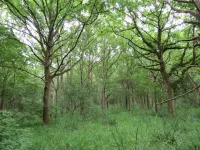(Press-News.org) A long-term passive rewilding study has shown that natural woodland regeneration could make a significant contribution to meeting the UK's ambitious tree planting targets - potentially at no cost and within relatively short timescales.
The research, led by the UK Centre for Ecology & Hydrology (UKCEH), found natural growth due to seed dispersal by birds, mammals and wind can produce biodiverse and resilient woodland.
Woodland development can be rapid, while avoiding the cost, management and plastic tubing involved in planting schemes.
The study - published in the journal PLOS ONE - found that after just 15 years, previously bare agricultural fields became a wildlife-rich shrubland. Within 40-50 years it had progressed to native closed-canopy oak, ash and field maple, with densities of up to 390 trees per hectare.
Meeting the Government's target to plant 30,000 hectares of woodland each year in the UK by 2025 is set to come at a high cost to the taxpayer, with schemes such as the £5.7 million 'Northern Forest' planned between Liverpool and Hull.
While natural regeneration relies on proximity to existing woodland or mature trees and is not suitable for all sites, the scientists involved in the study say incorporating passive rewilding into national planting targets could result in significant cost savings.
Their research has informed the Forestry Commission's new England Woodland Creation Offer scheme (EWCO), which is offering grants to landowners for natural tree colonisation for the first time.
Dr Richard Broughton of UKCEH, who led the study, says: "Biodiversity-rich woodland that is resilient to drought and reduces disease risk can be created without any input from us. Our study provides essential evidence that passive rewilding has the potential to expand native woodland habitat at no cost and within relatively short timescales.
"Natural colonisation could play a significant role in helping to meet the UK's ambitious targets for woodland creation, as well as nature recovery and net zero greenhouse gas emissions by 2050. It is an effective option for expanding woodland in many places without the costs of planting, the disease risk of transporting nursery-grown saplings, or using plastic tree tubes that are unsightly and pollute the environment."
Dr Broughton says the research also highlights the crucial role of natural seed dispersers such as wind, mammals and birds - especially jays, which are commonly regarded as pests by landowners and are persecuted for their predation of other birds. "The huge benefits that jays provide in natural colonisation by dispersing tree seeds, especially acorns, helps to create more woodland habitat for all wildlife and far outweighs any impact of predation," he adds.
The study was carried out by scientists from UKCEH as well as Bournemouth University; the Polish Academy of Sciences; the Natural Resources Institute in Finland; Pozna? University of Life Sciences in Poland; and the University of Cambridge.
The research team studied woodland development on two former agricultural fields over 24 and 59 years respectively - a two-hectare field of grassland abandoned in 1996 and a four-hectare barley field abandoned in 1961. The two sites are next to Monks Wood National Nature Reserve in Cambridgeshire, an ancient woodland that has been documented since 1279 AD.
The tree and shrub growth at Monks Wood has been monitored by researchers over several decades. This has included counting trees during field surveys as well as measuring vegetation heights and spatial cover using remote sensing data (Lidar laser scanning from aircraft).
Importantly, the study found the developing woodland was not hindered by herbivores such as deer and rabbits, so did not require fencing. Young trees were protected by the initial growth of bramble and thorny shrubs, giving truth to the old saying: 'The thorn is the mother of the oak'.
The young woodland was also resilient to periods of drought in dry summers, which will be important for future woodlands coping with climate change.
INFORMATION:
Further information
Broughton et al. 2021. Long-term woodland restoration on lowland farmland through passive rewilding. PLOS ONE. DOI: 10.1371/journal.pone.0252466
The research was completed under ASSIST, a National Capability programme (NE/N018125/1) funded by the Natural Environment Research Council (NERC) and the Biotechnology & Biological Sciences Research Council (BBSRC).
The researchers liaised with Natural England and Defra during their study, including site visits and workshops. Their work is informing afforestation policies, including the England Woodland Creation Offer (EWCO), which opened for grant applications on June 9.
Media enquiries
For interviews and information, please contact Simon Williams, Media Relations Officer at UKCEH, via simwil@ceh.ac.uk or +44 (0)7920 295384. The paper, images of woodland from the two study sites at Monks Wood after 24 years and 59 years respectively, are available on request.
About the UK Centre for Ecology & Hydrology (UKCEH)
The UK Centre for Ecology & Hydrology is a centre for excellence in environmental science across water, land and air. Our 500 scientists work to understand the environment, how it sustains life and the human impact on it - so that together, people and nature can prosper.
We have a long history of investigating, monitoring and modelling environmental change, and our science makes a positive difference in the world. The issues our science addresses include: air pollution, biodiversity, biosecurity, chemical risks, extreme weather events, droughts, floods, greenhouse gas emissions, land use, soil health, sustainable agriculture, sustainable ecosystems, sustainable macronutrient use, and water resources management.
The UK Centre for Ecology & Hydrology is a strategic delivery partner for the Natural Environment Research Council, part of UK Research and Innovation.
http://www.ceh.ac.uk / Twitter: @UK_CEH / LinkedIn: UK Centre for Ecology & Hydrology
Physicists at Ludwig-Maximilian University in Munich (LMU) and the Max Planck Institute for Quantum Optics (MPQ) have used ultrashort laser pulses to probe the dynamics of photoelectron emission in tungsten crystals.
Almost a century ago, Albert Einstein received the Nobel Prize for Physics for his explanation of the photoelectric effect. Published in 1905, Einstein's theory incorporated the idea that light is made up of particles called photons. When light impinges on matter, the electrons in the sample respond to the input of energy, and the interaction gives rise to what is known as the photoelectric effect. Light quanta (photons) are absorbed by the ...
Lugano, Switzerland, 17 June 2021 - Adding an immune checkpoint inhibitor to anti-HER2 treatment in breast cancer does not improve pathological complete response (pCR), according to the primary analysis of the IMpassion050 trial presented today during the ESMO Virtual Plenary. (1) The phase III trial is the first to report data comparing a neoadjuvant anti-HER2 based regimen with or without the anti-PD-L1 antibody atezolizumab in patients with high-risk, HER2-positive early breast cancer.
The standard treatment for high-risk, HER2-positive early breast cancer is dual anti-HER2 blockade plus chemotherapy. While antibody therapy may enhance innate and adaptive immunity and activate cellular cytotoxicity, there is evidence ...
(Boston)--An intrauterine fracture is a rare finding during routine prenatal imaging. This condition can be due to maternal trauma, genetic disorders of the skeleton, as well as other predisposing maternal metabolic and vascular disorders. Genetic disorders that have previously been reported to cause intrauterine fracture include brittle bone disease (osteogenesis imperfecta or OI), osteopetrosis, hypophosphatasia and Ehlers-Danlos syndrome (EDS).
Now for the first time, researchers from Boston University School of Medicine (BUSM) report a new genetic cause, unrelated to OI, for the 23 fractures that occurred in-utero to a mother with EDS hypermobility type.
EDS is a disease that weakens the bones and connective tissues ...
New study challenges long-standing assumptions about disease severity in infants, and suggests that standard qPCR interpretations underestimate the true burden of other highly contagious diseases, such as COVID-19 and influenza.
Pertussis, also known as "whooping cough," remains a significant cause of death in infants and young children around the world and, despite global vaccination programs, many countries are experiencing a resurgence of this highly contagious disease.
A new study by Boston University School of Public Health and the University of Georgia's Odum School of Ecology presents evidence that could help explain this ...
Bottom Line: Genetic mutations indicative of DNA damage were associated with high red meat consumption and increased cancer-related mortality in patients with colorectal cancer.
Journal in Which the Study was Published: Cancer Discovery, a journal of the American Association for Cancer Research
Author: Marios Giannakis, MD, PhD, an assistant professor of medicine at Harvard Medical School and a physician at Dana-Farber Cancer Institute
Background: "We have known for some time that consumption of processed meat and red meat is a risk factor for colorectal cancer," said Giannakis. The International Agency for Research on Cancer declared that processed meat was carcinogenic and that red meat was probably carcinogenic to humans in 2015.
Experiments ...
HOUSTON ? Preclinical research from The University of Texas MD Anderson Cancer Center finds that although glioblastoma stem cells (GSCs) can be targeted by natural killer (NK) cells, they are able to evade immune attack by releasing the TFG-β signaling protein, which blocks NK cell activity. Deleting the TFG-β receptor in NK cells, however, rendered them resistant to this immune suppression and enabled their anti-tumor activity.
The findings, published today in the Journal of Clinical Investigation, suggest that engineering NK cells to resist immune suppression may be a feasible path ...
The energy density of traditional lithium-ion batteries is approaching a saturation point that cannot meet the demands of the future - for example in electric vehicles. Lithium metal batteries can provide double the energy per unit weight when compared to lithium-ion batteries. The biggest challenge, hindering its application, is the formation of lithium dendrites, small, needle-like structures, similar to stalagmites in a dripstone cave, over the lithium metal anode. These dendrites often continue to grow until they pierce the separator membrane, causing the battery to short-circuit and ultimately destroying ...
Nitrogen from agriculture, vehicle emissions and industry is endangering butterflies in Switzerland. The element is deposited in the soil via the air and has an impact on vegetation - to the detriment of the butterflies, as researchers at the University of Basel have discovered.
More than half of butterfly species in Switzerland are considered to be at risk or potentially at risk. Usually, the search for causes focuses on intensive agriculture, pesticide use and climate change. A research team led by Professor Valentin Amrhein from the University of Basel, however, has been investigating another factor - the depositing ...
Living beings are continuously exposed to harmful agents, both exogenous (ultraviolet radiation, polluting gases, etc.) and endogenous (secondary products of cellular metabolism) that can affect DNA integrity. That's why cells are endowed with a series of molecular mechanisms whose purpose is to identify and signpost possible damage to the genetic material for speedy repair. These mechanisms are precisely regulated because they are key to cell survival. In extreme situations of massive and irreparable damage, cells enter a phase of controlled dismantling called "programmed cell death". Among the events that take place during this process is the massive delivery to the cytoplasm of a mitochondrial protein called cytochrome C. Under homeostatic conditions, this protein plays a role in energy ...
The 2018 Nobel Prize in Physics was shared by researchers who pioneered a technique to create ultrashort, yet extremely high-energy laser pulses at the University of Rochester.
Now researchers at the University's Institute of Optics have produced those same high-powered pulses--known as chirped pulses--in a way that works even with relatively low-quality, inexpensive equipment. The new work could pave the way for:
Better high-capacity telecommunication systems
Improved astrophysical calibrations used to find exoplanets
Even more accurate atomic clocks
Precise devices for measuring chemical contaminants in the atmosphere
In a paper in Optica, the researchers describe the first demonstration ...




